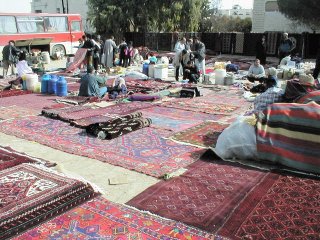
The Salon du Tapis d'Orient is a moderated discussion group in the manner of the 19th century salon devoted to oriental rugs and textiles and all aspects of their appreciation. Please include your full name and e-mail address in your posting.
by Filiberto Boncompagni
Part I - A Bus Called Daghestan
I’d like to show you the most exciting - for me, at least - activity in Amman, Jordan: a visit to the Hajj flea
market. Perhaps some of you remember my first posting on TurkoTek, almost a year ago, dealing with the same subject.
At the time I wrote:
Amman is on the route of Muslim pilgrims from the Caucasus to Mecca - for the Hajj. That means that from
time to time (mainly in the last month of the Muslim calendar for the main Hajj, but they continue all the year
around for the "smaller" Hajj) you see old buses and trucks parked on an empty ground near a Mosque -
or on the parking lot of Amman International Fair - with people from Daghestan (mainly, but also from Turkmenistan)
displaying an incredible array of goods on the dirt, no matter the weather.
It is a real and picturesque flea market: they sell everything from modern Chinese electronics to honey, old and
new kitchenware, Russian binoculars and cameras, old clothes and fabrics and, of course, CARPETS.
As I understood, it is a quite recent activity. It started after the collapse of the USSR, resuming an old tradition
between the Muslim pilgrims: trading goods in order to pay the expenses of the pilgrimage. Anyway, somebody from
Daghestan discovered that they could make a living from it, at least for few months each year. These are “economic
pilgrims”: most of them came on regular basis (a Muslim must perform a pilgrimage at least once, but is not required
to do it every year). Some do not even reach Mecca; coming here without the required visa for Saudi Arabia and
very often being refused entry there (the Saudis have quotas for each nationality - when the quota is full, they
don’t give visas anymore).
The pilgrims use two main routes: Iran -> Iraq -> Jordan, or Turkey -> Syria -> Jordan. Those passing
through Syria say they sell the best carpets there. Syrians are more knowledgeable and they are ready to pay for
quality. Here in Jordan, customers only want to buy cheap.
I’m told that a few years ago the quality of goods on offer was much better and prices were cheaper. Still, if
one looks hard, it is still possible to find something valuable.
Let’s start our tour. It’s time to use my digital camera.
This is one of the buses - small but comfortable.

obviously from Daghestan!

And here are the rugs.


These should be the ones from Turkmenistan.

This is my favorite spot - and it’s close to home.

Look, here’s the guy who sold me the Kazak last year!

Let’s make an interview. He speaks a little English. His name is Hashem or Mohammed Ali, it’s not clear which;
perhaps Hashem is the family name. He is 40 years old, married with 4 children, he drove from Ma(???) the capital
of Daghestan (I looked in the encyclopedia, it is Makhachkala) through Azerbaijan, Iran and Iraq. He shares the
bus with 11 other people, including his wife. They paid $3,000 for the bus, but in all it costs each person around
$1,200 to go to Saudi Arabia and back. At home he earns $ 30/40 per month buying/selling carpets, milk, honey,
walnuts and driving trucks.
He bought his rugs in Daghestan and Azerbaijian. On the way they had “lots of problems” in Iran, “customs were
very greedy” and levied money on everything. They had also to pay $600 for the bus “but Jordan is good because
they give us water, food and places to camp.”
Ladies and Gentlemen, would you please follow me to Part II?